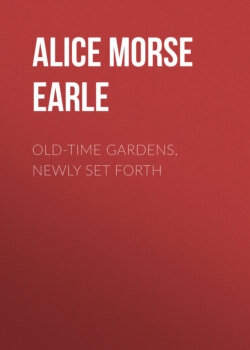Old-Time Gardens, Newly Set Forth

Реклама. ООО «ЛитРес», ИНН: 7719571260.
Оглавление
Alice Morse Earle. Old-Time Gardens, Newly Set Forth
Old-Time Gardens, Newly Set Forth
Table of Contents
CHAPTER I
CHAPTER II
CHAPTER III
CHAPTER IV
CHAPTER V
CHAPTER VI
CHAPTER VII
CHAPTER VIII
CHAPTER IX
CHAPTER X
CHAPTER XI
CHAPTER XII
CHAPTER XIII
CHAPTER XIV
CHAPTER XV
CHAPTER XVI
CHAPTER XVII
CHAPTER XVIII
CHAPTER XIX
CHAPTER XX
CHAPTER XXI
CHAPTER XXII
Index
Отрывок из книги
Alice Morse Earle
Published by Good Press, 2019
.....
There is little evidence that a general love and cultivation of flowers was as common in humble homes in the Southern colonies as in New England and the Middle provinces. The teeming abundance near the tropics rendered any special gardening unnecessary for poor folk; flowers grew and blossomed lavishly everywhere without any coaxing or care. On splendid estates there were splendid gardens, which have nearly all suffered by the devastations of war—in some towns they were thrice thus scourged. So great was the beauty of these Southern gardens and so vast the love they provoked in their owners, that in more than one case the life of the garden's master was merged in that of the garden. The British soldiers during the War of the Revolution wantonly destroyed the exquisite flowers at "The Grove," just outside the city of Charleston, and their owner, Mr. Gibbes, dropped dead in grief at the sight of the waste.
The great wealth of the Southern planters, their constant and extravagant following of English customs and fashions, their fertile soil and favorable climate, and their many slaves, all contributed to the successful making of elaborate gardens. Even as early as 1682 South Carolina gardens were declared to be "adorned with such Flowers as to the Smell or Eye are pleasing or agreeable, as the Rose, Tulip, Lily, Carnation, &c." William Byrd wrote of the terraced gardens of Virginia homes. Charleston dames vied with each other in the beauty of their gardens, and Mrs. Logan, when seventy years old, in 1779, wrote a treatise called The Gardener's Kalendar. Eliza Lucas Pinckney of Charleston was devoted to practical floriculture and horticulture. Her introduction of indigo raising into South Carolina revolutionized the trade products of the state and brought to it vast wealth. Like many other women and many men of wealth and culture at that time, she kept up a constant exchange of letters, seeds, plants, and bulbs with English people of like tastes. She received from them valuable English seeds and shrubs; and in turn she sent to England what were so eagerly sought by English flower raisers, our native plants. The good will and national pride of ship captains were enlisted; even young trees of considerable size were set in hogsheads, and transported, and cared for during the long voyage.
.....